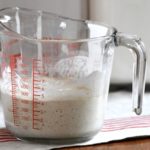How to Make Sourdough Starter From Scratch
It’s easy to make a healthy sourdough starter from scratch. All it takes is patience and a little know-how. Here is everything you need to know to make a bubbling and delicious sourdough starter.
- Prep Time: 5 minutes
- Total Time: 5 minutes
- Yield: Approximately 1/2 cup 1x
- Category: Bread
- Method: Sourdough
- Cuisine: Traditional
- Diet: Vegan
Ingredients
Units
Scale
- 1 oz flour (approx. 3 Tbsp)
- 1 oz tap water (1.5 Tbsp)
- Additional flour and water as needed, see notes
Instructions
- If you’re new to sourdough, I recommend reading the 6 sections above. They cover everything you need to know about catching and maintaining a sourdough starter.
- Make sure to use flour that doesn’t contain any additives and beware of bread flour. The additives do not help catch and maintain a sourdough starter. It’s best if you can find plain milled flour (all-purpose or whole grain flour).
- Create your starter by mixing the flour and water in a glass container. Mix it with a fork and loosely cover with a tea towel and leave it in a warm spot. (Above the fridge works well).
- Check the starter twice a day and stir vigorously with a fork to bring air into the mixture. It should start forming bubbles within 2 to 7 days (depending on your air quality, see above for details).
- Once it has started to smell sour and is bubbling, then you need to feed the starter daily. For the first feeding add 2 oz (6 Tbsp) of flour and 2 oz (3 Tbsp) of water and mix vigorously to incorporate air.
- Keep feeding the starter daily (see section above for details). Within 4-5 days, of feeding, you should have an active, bubbling culture. That means you are ready to bake bread!
Notes
- Most urban tap water contains chlorine, which can slow fermentation. So if you can, use filtered water. However, it’s also fine to use plain tap water as the chlorine will naturally dissipate within 12 hours.
- I don’t believe in wasting sourdough starter, which is why I only start feeding my starter AFTER it has started to bubble. There’s just no point in adding a bunch of flour and water before you’ve caught the culture. See the sections above for information on how to feed your sourdough starter and avoid sourdough discard.
- The process is fairly similar for catching a GF starter. However, I recommend reading my post on gluten-free sourdough starter for details on the different GF flour types.
Find it online: https://www.fermentingforfoodies.com/sourdough-starter/
